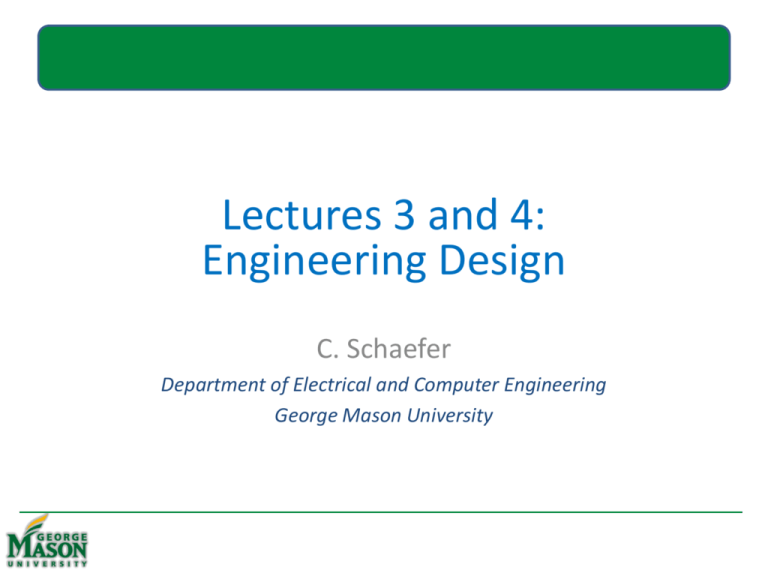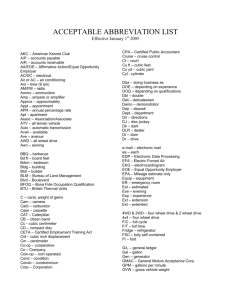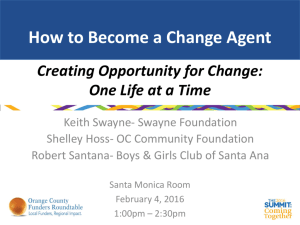
Lectures 3 and 4:
Engineering Design
C. Schaefer
Department of Electrical and Computer Engineering
George Mason University
Administrivia
• Web site URL for new students:
– http://mason.gmu.edu/~cschaef3/
• Semester Project
– Team assignments
– Design Brief
• Complete Intro to Design Process today
• Homework:
– Your choice of either: 3.3, 3.4, 3.5, or 3.10. Prepare a 1 – 2
page report on your findings.
– Homework due at the beginning of next class
Impromptu Design Projects
• Impromptu design teams will normally be no
larger than 4 students
• First Impromptu Design Project Today (see page
25 of the book)
• Next week’s Impromptu Design Project:
– Problem 3.11 in Chapter 3.
– Two minor differences:
• You will be provided 6 feet of aluminum foil
• The boat must fit within a 8” x 6” rectangle (no height
restriction)
• I will bring the pennies and the tub to test your designs.
• You will have 20 minutes to complete your boat so begin
thinking of a design
ENGR107 – Engineering Fundamentals
3
Outline
In this lecture we will
• Introduce you to the engineering design process
• Discuss the basic steps that most engineers follow
when designing a product
• Discuss the importance of considering
sustainability in design
Outline
• Introduce important design factors such as
Teamwork
Project scheduling
Material selection
Economic consideration
Engineering standards and codes
References
• Systems Engineering and Analysis, Second Edition, Benjamin
S. Blanchard and Wolter J. Fabrycky, Prentice Hall, 1990.
(This is the “bible” on systems engineering).
• Engineering: An Introduction to a Creative Profession, Fifth
Edition, George C. Beakley, Donovan L. Evans, John Bertrand
Keats, Macmillan Publishing Company, 1986.
What is Engineering Design?
• Engineering Design is a process of devising a
system, component, or process to meet a desired
need.
• It is a decision-making process, often iterative, in
which the basic sciences, mathematics, and
engineering sciences are applied to convert
resources to meet a stated objective.
• Structured problem-solving activity
Design Process – Basic Steps
Your book outlines these steps:
1. Recognizing the need for a product or a service
2. Problem definition and understanding
3. Research and preparation
4. Conceptualization
5. Synthesis
6. Evaluation
7. Optimization
8. Presentation
Analytic and Creative Problem Solving1
•
•
•
•
•
•
•
•
•
•
Identify the problem.
Define the working criteria or goals.
Research and gather data.
Brainstorm for creative ideas.
Analyze.
Develop models and test.
Make the decision.
Communicate and specify.
Implement and commercialize.
Prepare post-implementation review and assessment.
1Oakes,
et al
Contrast with Scientific Method
•
•
•
•
•
Define the problem.
Gather the facts.
Develop a hypothesis.
Perform a test.
Evaluate the results.
Notice that science is not overly concerned
with implementation, only knowledge
gathering.
Design Process – Basic Steps
Step 1: Recognizing the need for a product
or a service
Design Process – Basic Steps
Step 2: Problem definition and understanding
• This is the most important step in any design
process
• Before you move on to the next step
Make sure you understand the problem
Make sure that the problem is well defined
• Good problem solvers are those who first fully
understand what the problem is
Design Process – Basic Steps
Step 3: Research and preparation
• Collect useful information
Search to determine if a product already exists
Perhaps you could adopt or modify existing
components
Review and organize the information collected in a
suitable manner
Step 4: Conceptualization
Generate ideas or concepts that could offer reasonable
solutions to your problem
Design Process – Basic Steps
Step 5: Synthesis
• At this point you begin to consider details
• Perform calculations, run computer models, narrow
down the type of materials to be used, size the
components of the system, and answer questions
about how the product is going to be fabricated
• Consult pertinent codes and standards for compliance
Design Process – Basic Steps
Step 6: Evaluation
• Analyze the problem in more detail
• Identify critical design parameters
and consider their influence in your
final design
• Make sure that all calculations are
performed correctly
• Best solution must be identified
from alternatives
•
Details of design must be
worked out fully
Design Process – Basic Steps
Step 7: Optimization – minimization or maximization
• Optimization is based on some particular criterion such
as cost, strength, size, weight, reliability, noise, or
performance.
• Optimizing individual components of an engineering
system does not necessarily lead to an optimized
system
Design Process – Basic Steps
Step 8: Presentation
• You need to communicate your solution to the
client, who may be your boss, another group within
your company, or an outside customer
• Engineers are required to give oral and (written)
progress reports on a regular basis to various
groups; consequently, presentation could well be
an integral part of many other design steps
Flow Diagram for Design Process
Conceptual
Design
Preliminary
Design
Detailed
Design
Prototype
Design
Design
Evaluation
Design
optimization
Design
Evaluation
Design
Evaluation
Final
Design
Real-World Engineering Development Process?
Enthusiasm.
Disillusionment.
Panic.
Search for the guilty party.
Punishment of the innocent party.
Fame and honor for the non-participants.
Taken from: OMNI Magazine, July 1980.
Four Primary Phases of the System Life Cycle
Conceptual- Detail
Production
Preliminary Design and and/or
Design
Development Construction
LCC = Acquisition costs +
Product Use,
Phase out,
and Disposal
Sustaining Costs
Life Cycle Costs
20
Automobile LCC Fictional Costs
BMW 3-Series vs. Mercedes C-Class
Acquisition
Costs
Sustaining
Costs
Design Process – Basic Steps
An optimization
procedure
Example 3.1 – Optimization
Given:
To purchase storage tanks with a budget of $1680. Available floor
space is 90 ft2
Manufacturer A:
16 ft3 capacity @ $120 each, requires 7.5 ft2 floor space
Manufacturer B:
24 ft3 capacity @ $240 each, requires 10 ft2 floor space
Find:
Greatest storage capacity within the budgetary and floor-space
limitation
Example 3.1 – Optimization
Solution:
Let x1 = 16 ft3 capacity and x2 = 24 ft3 capacity. Then the
objective function Z we wish to maximize becomes
maximize Z = 16x1 + 24x2
Example 3.1 – Optimization
Region as given by linear
inequality
Feasible solution
Other Engineering Design Considerations
• Engineering economics
• Material selection
• Teamwork
• Conflicts Resolution
• Project scheduling and task chart
• Evaluating alternatives
• Patent, trademark, and copyright
• Engineering standards and codes
Engineering Economics
More in
Chapter
20
• Economic factors always play important roles in
engineering design decision making
• Products that are too expensive cannot be sold at a
price that consumers can afford and still be
profitable to the company
• Products must be designed to provide services not
only to make our lives better but also to make
profits for the manufacturer
Material Selection
• Selection of materials is an important design decision
• Examples of properties to consider when selecting materials
Density
Ultimate strength
Flexibility
Machinability
Durability
Thermal expansion
Electrical & thermal conductivity
Resistance to corrosion
Material Properties
• Material properties depend on many factors
How the material was processed
Its age
Its exact chemical composition
Any nonhomogenity or defect within the material
• Material properties change with temperature and time as the
material ages
• In practice, you use property values provided by the
manufacturer for design; textbook values are typical values
Material Properties
•
•
•
•
•
•
•
•
•
Electrical resistivity
Density
Modulus of Elasticity
Modulus of Rigidity
Tensile strength
Comprehensive strength
Modulus of resilience
Modulus of toughness
Strength-to-Weight ratio
© 2011 Cengage Learning Engineering. All Rights Reserved.
•
•
•
•
•
•
Thermal expansion
Thermal conductivity
Heat capacity
Viscosity
Vapor pressure
Bulk modulus of
compressibility
3-30
Teamwork
• Design team
a group of individuals with complementary
expertise, problem solving skills, and talent
who are working together to solve a problem
or achieve a common goal
• Employers are looking for individuals who not only
have a good grasp of engineering fundamentals
but who can also work well with others in a team
environment
Common Traits of Good Teams
Successful teams have the following components:
• The project that is assigned to a team must have
clear and realistic goals. These goals must be
understood and accepted by all members of the
team.
• The team should be made up of individuals with
complementary expertise, problem solving skills,
background, and talent.
• The team must have a good leader.
Common Traits of Good Teams
• The team leadership and the environment in
which discussions take place should promote
openness, respect, and honesty.
• The team goals and needs should come before
individual goals and needs.
Secondary Roles of Good Team Members
• The Organizer – experienced and confident; trusted by
members of the team and serves as a coordinator for
the entire project
• The Creator – good at coming up with new ideas,
sharing them with other team members, and letting
the team develop the ideas further
• The Gatherer – enthusiastic and good at obtaining
things, looking for possibilities, and developing
contacts
Secondary Roles of Good Team Members
• The Motivator – energetic, confident, and outgoing;
good at finding ways around obstacles
• The Evaluator – intelligent and capable of
understanding the complete scope of the project;
good at judging outcomes correctly
• The Team Worker – tries to get everyone to come
together, does not like friction or problems among
team members
Secondary Role of Good Team Members
• The Solver – reliable and decisive and can turn
concepts into practical solution
• The Finisher – can be counted on to finish his or
her assigned task on time; detail oriented and may
worry about the team’s progress toward finishing
the assignment
Other Factors Influencing Team Performance
• The way a company is organized
• How projects are assigned
• What resources are available to a team to perform
their tasks
• Corporate culture: whether openness, honesty,
and respect are promoted
Conflicts
When a group of people work together, conflicts
sometimes arise. Conflicts could be the result of
• Miscommunication
• Personality differences
• The way events and actions are interpreted by a
member of a team
Conflict Resolution
• Managing conflicts is an important part of a team
dynamic
• In managing conflicts, it is important to recognize
there are three types of people:
Accommodating
Compromising
Collaborative
Conflict Resolution – Type of People
• Accommodating team members - avoid conflicts
Allow assertive individuals to dominate
Making progress as a whole difficult
Could lead to poor team decision
Conflict Resolution – Type of People
• Compromising team members
Demonstrate moderate level of assertiveness
and cooperation. By compromising, the team
may have sacrificed the best solution for the
sake of group unity
Conflict Resolution
• Collaborative Conflict Resolution Approach
High level of assertiveness and cooperation by
the team
No finger pointing
Team proposes solutions
Means of evaluation
Combine solutions to reach an ideal solution
Project Scheduling and Task Chart
A process that engineering managers use to ensure that a project
is completed on time and within the allocated budget
Evaluating Alternatives
• When a design is
narrowed down to a few
workable concepts,
evaluation of these
concepts is needed
before detail design is
pursued
• Each design would have
its own evaluation
criteria
An Example of evaluation worksheet
Sustainability in Design
Sustainability and sustainable engineering can be
defined as
“design and development that meets the needs of
the present without compromising the ability of
future generations to meet their own needs.”
Sustainability in Design
• Engineers contribute to both private and public sectors of
our society
• In private sector, they design and produce the goods and
services that we use in our daily lives to allow us to enjoy a
high standard of living
• In public sector, they support local, state, and federal
mission such as meeting our infrastructure needs, energy
and food security, and national defense
Sustainability in Design
• Increasingly, because of worldwide socioeconomic trends,
environmental concerns, and earth’s finite resources, more is
expected of engineers
• Future engineers are expected to design and provide goods
and services that increase the standard of living and advance
health care, while addressing serious environmental and
sustainability concerns
• In designing products and services, engineers must consider
the link among earth’s finite resources, environmental, social,
ethical, technical, and economical factors
Summary
• You should know the basic design steps that all
engineers follow, regardless of their background, to
design products and services
• You should realize that economics plays an important
role in engineering decision making
• You should realize that the selection of material is an
important design decision
• You should be familiar with the common traits of good
teams
Sport Utility Vehicle (SUV)
Anti-Lock Braking System (ABS)
Identification of Problem
•
•
•
•
What is required?
What must be done and why?
Scope of problem – define problem
boundaries.
Example – Anti-lock Braking System
– Is it possible to successfully retrofit an ABS
developed for compact cars to heavier, sports
utility vehicles?
Research the Problem
• Can we decompose the problem into easily
managed subproblems?
• This step defines, for example;
– Literature review for similar problems and
solutions to those problems.
– Relevant analytical and modeling techniques.
– Testing requirements.
– Design constraints.
– Resource requirements and allocation.
– Project schedule.
Research – ABS Example
• Literature search; Internet search on ABS.
• Constraints (example);
– Retain compact car ABS system architecture.
– SUV ABS costs cannot exceed 110% of current compact car
ABS system cost.
– Time to market – 3 months.
– Performance criteria;
• SUV Total Time to Stop 15% increase over compact car.
• SUV Wheel Lock Skid Time 10% increase over compact car.
• Approach:
– Develop MATLAB model of ABS system.
– Parametric analysis using model.
– Modify system constants.
Solve the Problem
• Develop alternatives. For example;
– Hardware and software design alternatives.
– List of independent variables to vary in modeling or
simulation.
• Modeling
–
–
–
–
–
Conceptual models.
Physical models and engineering mockups.
Graphical models.
Mathematical models.
Computer models.
Decision Matrix
Alternative Solutions
Criteria
Weight
Ease of Ass 35%
Score
Functionality 25%
Score
Cost
25%
Score
Stability
15%
Score
Total Score 100%
1
2
4
5
140
5
175
125
6
150
7
105
520
4
6
8
200
8
280
8
5
150
200
7
125
3
9
45
570
Rating
R=9
200
7
175
9
135
670
Example
9 - 10'
7-8'
5 - 6'
3 - 4'
0 - 2'
280
8
200
6
5
8
210
8
Rating scale R
Excellent
Good
Fair
Poor
Unsatisfactory
3
9 W = 25
225 RxW
9x25 = 225
10
135
790
175
150
805
Solve the Problem
• Experimentation
– Computer simulation.
– Testing, for example;
• Ground tests.
• Flight testing.
• Synthesis
– Subproblem solutions are merged.
– E.g., manufacturing and engineering resolving
issues associated with manufacturability.
Solve Problem – ABS Example
• ABS hardware and system architecture fixed
with exception of interface to SUV.
• Control software can be modified.
• Matlab simulation.
• Skid pad testing to verify simulation results.
• Presentation of results to Product
Development Team.
ABS Braking Simulation Model
ABS Braking Model
100
0.2
1
TB.s+1
Desired
relative
slip
Bang-bang
controller
Kf
s
Brake
pressure
Hydraulic Lag
1/I
brake torque
Force &
torque
s
tire torque
ctrl
m*g/4
mu-slip
friction curve
Weight
slp
s
Vehicle
speed
Mux
yout
Vehicle speed
(angular)
1
-1/m
Wheel
Speed
1/Rr
Rr
Ff
1
STOP
1
s
Stopping distance
1.0 - u(1)/(u(2) + (u(2)==0)*eps)
Relative Slip
Double click to
run model and
plot the results
Developed by Larry Michaels
The MathWorks, Inc
Simulation Results
Vehicle speed and wheel speed
80
Vehicle Weight = 1600lbs
Hydraulic Lag – 0.01 sec
70
60
Vehicle speed (wv )
Speed(rad/sec)
50
40
30
20
Wheel speed (ww )
10
0
0
5
10
Time(secs)
15
Simulation Results
Vehicle speed and wheel speed
80
Vehicle Weight = 2900 lbs
Hydraulic Lag – 0.01 sec
70
60
Vehicle speed (wv )
Speed(rad/sec)
50
40
30
20
Wheel speed (ww )
10
0
0
2
4
6
8
10
Time(secs)
12
14
16
18
Simulation Results
Vehicle speed and wheel speed
80
Vehicle Weight = 2900 lbs
Hydraulic Lag – 0.03 sec
70
60
Vehicle speed ( w )
Speed(rad/sec)
v
50
40
30
20
Wheel speed ( w )
w
10
0
0
2
4
6
8
10
Time(secs)
12
14
16
18
Simulation Results
Vehicle speed and wheel speed
80
Vehicle Weight = 2900 lbs
Hydraulic Lag – 0.007 sec
70
60
Vehicle speed (wv )
Speed(rad/sec)
50
40
30
20
Wheel speed (ww )
10
0
0
2
4
6
8
Time(secs)
10
12
14
16
Presentation
Anti-Lock Braking System Simulation Results
Baseline
Vehicle
Weight
(lbs)
Hydraulic
System
Time
Constant
(sec)
Total
Time to
Stop
(sec)
Wheel
Lock Skid
Time (sec)
1600
2900
2900
2900
0.010
0.007
0.010
0.030
14.00
15.80
16.00
16.50
0.25
0.25
0.80
2.00
Best Solution
Testing - ABS
Presentation
Total Time to Stop (sec)
TTS vs. Hydraulic Time Constant
16.60
16.40
Wt = 2900 lbs
16.20
16.00
15.80
Is this relationship linear or
nonlinear?
15.60
15.40
0.007
0.010
0.030
Hydraulic System Time Constant (sec)
Presentation
Wheel Lock Skid
Time (sec)
Wheel Lock Skid Time vs. Hydraulic
Time Constant
2.50
2.00
Wt = 2900 lbs
1.50
1.00
0.50
0.00
0.007
0.010
0.030
Hydraulic System Time Constant (sec)
Results
• Performance Criteria Satisfied.
• Total Time to Stop
– Required – 15% increase over compact car.
– Actual – 12.8% increase.
• Wheel Skid Lock Time
– Required – 10% increase over compact car.
– Actual – 0% increase over compact car.
• Time to market – 1.5 months for S/W revisions.
• Cost – Less than a 2% increase.
Engineering Design
Questions?







